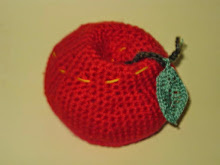Hyperbolic Crochet Snail or Seashell
The model is crocheted in half treble, 1 ply wool, starting with one stitch and increasing according to the series F(n) = 2F(n-2) + F(n-3), as given here.
Rows alternate, so that the increasing stitches are at the beginning of each row.
This creates a classic hyperbolic shape. It is interesting to see that the beginning and the end are in close to each other
To make up the model, fold in half. It configures neatly into a left hand or right hand spiral. Most shells in nature are right hand spirals.
Continue sewing the two sides together of the last row, while softly padding the spiral with wool fleece or cotton wool as you go.
Fibonacci Series
F1 0
F2 1
F3 1
F4 2 =2x1 +0
F5 3 =2x1 +1
F6 5 =2x2 +1
F7 8 =2x3 +2
F8 13 =2x5 +3
F9 21 =2x8 +5
F10 34 =2x13 +8
F12 89 =2x34 +21
F13 144 =2x55 +34
F14 233 =2x89 +55
F15 377 =2x144 +89
F16 610 =2x233 +144
F17 987 =2x377+233
F18 1597 =2x610 +377
This series holds true forever along the Fibonacci series. As you can see, there are series within series.
The sum total
F1 + F2+…….Fn = F(n+2) minus 1
This is useful to figure how many stitches are made from one skein of cotton or wool, and to plan accordingly how much material is need to complete a shape, various colours.
eg. F1 + F2+… F13 =376 =F15 minus 1.
One skein made 13 rows, that is 376 stitches.
Thursday, April 29, 2010
Subscribe to:
Post Comments (Atom)

No comments:
Post a Comment